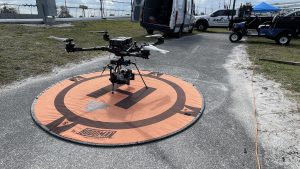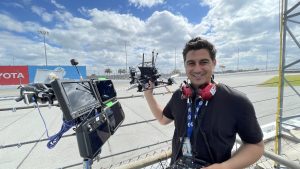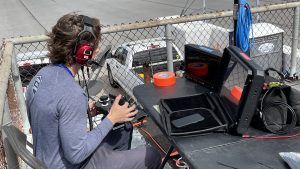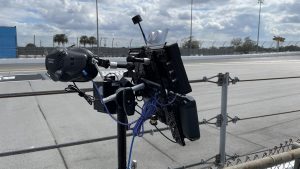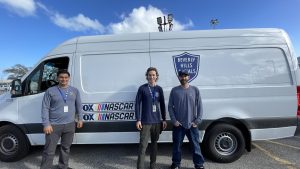Live From Daytona 500: Beverly Hills Aerials Takes to the Sky With FPV Racing, Heavy Lift Drones
This will be the company’s third straight race
Story Highlights
Since the 62nd running of the Daytona 500 two years ago, live drone coverage has become a common broadcast tool for NASCAR on Fox. Beverly Hills Aerials, a provider of cinematic shots from multiple drones, were working their first race in 2020. Since then, they have exploded onto the live-sports scene and will continue with both their FPV racing and heavy lift drones on Sunday.
“We want to push what the drones are capable of doing,” says Michael Izquierdo, chief pilot, Beverly Hills Aerials. “It’s all about keeping up with the speed of the cars.”
MORE FROM DAYTONA 500
- Fox Sports Makes 2022 NASCAR Season Debut With 1080p HDR Broadcast, Massive Onsite Presence
- TD John Howard Pulls Double Duty at Super Bowl LVI, Super Bowl of Racing
- Fox Sports Studio Team Parks in Old Victory Lane for Stunning Backdrop
- Fox Sports Will Still ‘Crank It Up’ for the Iconic Race
- SMT Amplifies Fox Sports’ New Graphics Package With Heart Rate Telemetry, Real-Time Position Tracking
- BSI Adapts to Next-Gen Cars With New Front, Rear Bumper Cams
- Game Creek Video Readies Encore Mobile Unit for NASCAR on Fox Season Opener
Down in Daytona: Heavy Lift, FPV Racing Drone Take Flight
For their third consecutive Daytona 500, the team will have a flying zone that includes the entire backstretch, halfway through the turns, two-thirds of the 29-acre Lake Lloyd, and the start/finish line for coverage of burnouts by the winning driver. The total amount adds up to a little over a mile.
Leading the way will be two separate drones with two drastically different use cases. The heavy lift drone — equipped with a RED KOMODO camera and Angenieux zoom lens — will be a more stationary feature in the sky. Since it’s traveling at slower speeds, the flight time is around 10 to 12 minutes. On the other end of the spectrum, the FPV racing drone — flying high with a GoPro HERO 10 — will hover close to 100 mph hour for quick movements that keeps pace with the cars on the ground.
“The HERO 10 on the FPV drone has built-in stabilization, so it should make the shots look a little smoother,” says Izquierdo. “It’s a tough environment to fly in since it’s windy and hot, but when you’re going 100 mph, we still want to get smooth shots.”
Sunday’s contest won’t be the crew’s first race in 2022. Recruited for the Clash at the Coliseum in Los Angeles, the drones covered the space near the track and the surrounding area. Their involvement in the race on the West Coast and this upcoming broadcast on the East Coast is a positive step in gaining extra room to wonder at each speedway.
“NASCAR is starting to relinquish their grip on where we can control our drones,” says Caleb Descognets, chief aerial DP, Beverly Hills Aerials. “We’re really excited about that because we’ve been confined into the inner ring of the infield for all of our flights.”
Trackside Workflows: Three-Person Staff Handle Operations Near the Asphalt
Along with a larger zone for flying, the company hopes to garner different looks for the production team of Fox Sports. Through constant communication with NASCAR on Fox Director Artie Kempner, Aerial DP Chase Ellison is doing his best to cater to the broadcast needs at any given time.
“Working with Artie feels like a true partnership because you can pitch ideas to him and he’ll listen to you,” says Ellison. “He’s really great at giving us time to get the drone in the air and set up the shot that he wants.”
While Chase controls the camera and Michael controls the drone, Technician Kevin Paschal is putting out any fires that pop up during practice and the live show. His duties include fixing misplaced antennas, changing and recharging batteries, or reattaching any essential piece of the drone that’s not latched correctly. When he’s not solving current problems, he’s working to get ahead of any future ones by designing new concepts.
“We’re always trying to improve and evolve to make things more efficient,” says Paschal. “The biggest challenge for me is making sure that our systems are optimized to where we can act fast in the field. Ideally, we want to be up in the air as much as possible.”
Super Bowl LIV Reflections: Crew Closes Out Action-Packed Week
Before heading to the Sunshine State, Beverly Hills Aerials worked at another marquee event in their own backyard: Super Bowl LVI at SoFi Stadium in Los Angeles. Unable to capture live shots of the action due to the enclosed nature of the venue, the team relied on the BHA Titan heavy lift drone, which was outfitted with a Sony HDC-P50 and an AVS transmitter. Working with NBC Sports and NFL Network, Izquierdo and his onsite team presented beauty shots of the lakeside sets outside of SoFi Stadium and the smaller setup at the Santa Monica Pier.
“We were allowed to be over the 1,000-ft. wide lake right in front of SoFi Stadium and 200 ft. up in the air, so 50 ft. above the stadium,” says Izquierdo. “It was a pretty good space to play with because of the Super Bowl LVI and SoFi Stadium signs.”
Aside from operating over multiple bodies of waters, the major logistical hurdle for the crew was overcoming the huge amounts of connectivity congestion at two populated areas. Along with the NFL’s Frequency Coordinator Loren Sherman, the drones were operating on a different channel to sidestep around other intercom frequencies
“We had the entire system around 2.4 GHz, which isn’t as robust as 900 GHz, but we figured it out,” says Descognets. “Having to go back to older technology was a bit of a task, but we had boosters for the signals and modified our gimbal and camera controller.”
Eyes on the Future: Beverly Hills Aerials Looks Forward to Continued Growth
Occupying a large chunk of the live drone space, Bevery Hills Aerials is charting on a course that’s built on a passion for flying the latest piece of remote-controlled devices. In what began as a response to the high demand for aerial drone shots, the company has turned into a critical part on some of sports’ highly televised events. The future is bright, but for now, the team is soaking up every second of these productions.
“It’s been a wild month for us, and we still have a ton of room to grow, but we’ve tried to not grow too fast,” says Izquierdo. “We have a small group of incredibly talented people, and when the time is right, we’ll expand.”
